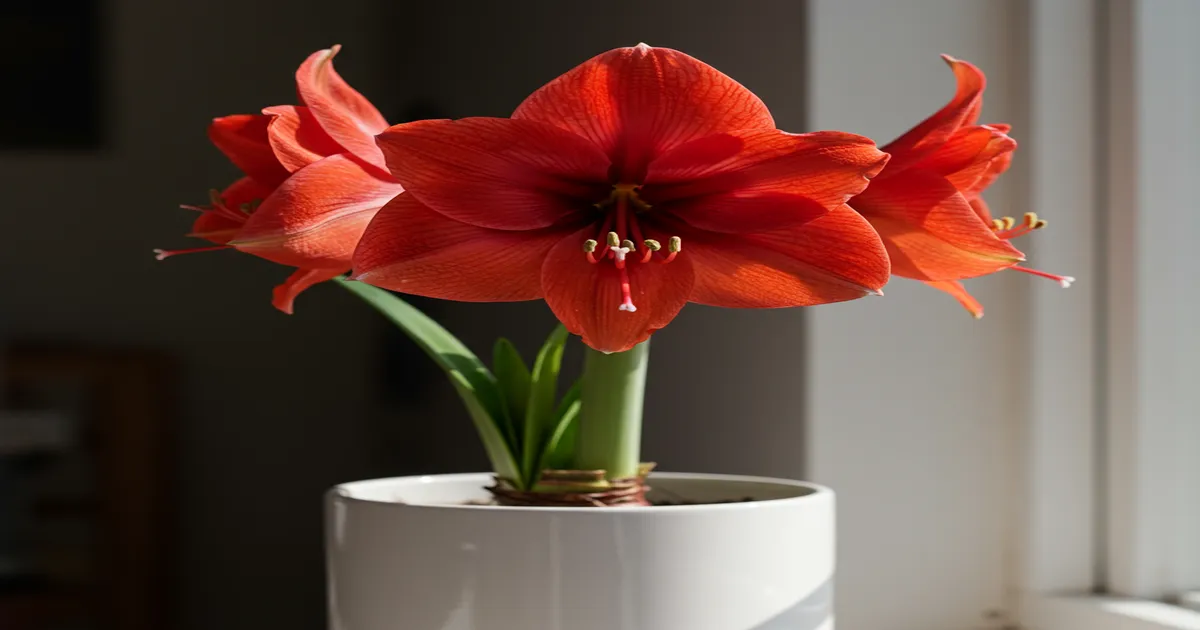Many individuals cultivate amaryllis bulbs to enjoy indoor plants blooming during the winter months. Amaryllis flowers are typically hybrids derived from various species within the Hippeastrum genus, a collection of tropical plants originating from Central and South America.
There is also a distinct Amaryllis genus, which comprises only two species indigenous to South Africa. However, these are not the amaryllis plants commonly grown in the United States.
| Common Name | Amaryllis |
| Botanical Name | Hippeastrum (group) |
| Family | Amaryllidoideae |
| Plant Type | Perennial, bulb |
| Mature Size | 1–2 ft. tall, 9–12 in. wide |
| Sun Exposure | Full, partial |
| Soil Type | Well-drained |
| Soil pH | Acidic, neutral |
| Bloom Time | Seasonal |
| Flower Color | Red, pink, white |
| Hardiness Zones | 8–10 (USDA) |
| Native Area | Central America, South America |
| Toxicity | Toxic to humans, toxic to pets |
Varieties of Amaryllis

There is a wide selection of amaryllis varieties available, and the best choice will depend on the color of flowers that attract you the most. Some recommended options include:
- ‘Samba’: This type features large red ruffled blooms with white markings.
- ‘Apple Blossom’: This popular variety showcases blooms with a blend of pink and white colors and green throats.
- ‘Faro’: This plant produces delicate flowers in pale salmon and white hues, with smaller and more delicate blooms compared to most varieties.
- ‘Summertime’: This variety boasts large seven-inch blooms in a unique range of watermelon pink to dark rose tones with greenish centers.
- ‘Matterhorn’: This is a great option for a pure white amaryllis, featuring yellow-green throats.
Trimming

Once the flowers wither, trim the flower stem to just above the bulb. Continue to water the plant until it becomes dormant in autumn. You can transfer the amaryllis outside during the summer, positioning it in a spot with partial shade.
Growing Amaryllis Through Propagation
Amaryllis bulbs will create small side bulbs in a similar way to daffodils reproducing. You can delicately separate these tiny bulbs and plant them to generate more plants after the original plant has become dormant and its flowers have withered—typically late winter to early spring for outdoor plants and fall for indoor plants.
Wintering
Amaryllis plants within USDA hardiness zones 8 to 10 can be left untouched during the winter season. However, in zone 7, they can be wintered in the garden by adding a thick layer of mulch.
In different zones, it is recommended to preserve amaryllis bulbs for the following year by delicately taking the bulb out of the garden bed and storing it in a cool, dry, dark place.
Common Pests & Plant Diseases
It is important to remain vigilant for spider mites and mealybugs, as they can be controlled with horticultural oil. Outdoor plants may fall victim to slugs and snails.
Amaryllis plants can also fall prey to red blotch and mosaic virus infections. Red blotch spreads quickly from one bulb to another, appearing as reddish-brown spots on leaves, bulbs, and scapes.
Plants infected with the mosaic virus will exhibit reduced blooming and growth, with leaves showing yellow streaks. Unfortunately, there are no effective treatments for these diseases.
Tips for Encouraging Amaryllis Blooms
Amaryllis planted in a frost-free garden (USDA hardiness zones 8 to 10) will typically bloom in March, April, and May, with a chance of re-blooming in the fall. To achieve a holiday bloom when growing amaryllis as potted plants, it’s crucial to plant the dormant bulbs about 10 to 12 weeks before the desired blooming period.
When purchasing commercial bulbs from a grower for holiday bloom, make sure to store the dormant bulbs in a cool, dark, dry location until it’s time to plant them.
For existing potted amaryllis plants, you can influence blooming by moving them outdoors during the summer, bringing them back indoors at the season’s end, reducing water and fertilizer to induce dormancy, and then restarting the bulbs.
If your amaryllis fails to bloom, it may be due to a lack of rest after the previous bloom or insufficient light exposure.
FAQ
How can I make my amaryllis bloom again?
To encourage your amaryllis to bloom again after its spring/summer flowering, stop watering and feeding it in late summer. Place the plant in a dark, cool, dry area, remove the faded foliage, and after eight to ten weeks, return it to a warm spot with indirect bright light, watering it thoroughly. New leaves will emerge first, followed by flowers.
What is the lifespan of amaryllis?
An amaryllis bulb can live up to 25 years, during which it will produce offshoots (bulbils) and create new plants.

